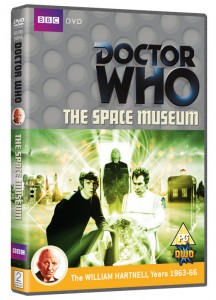 Welcome to the twelfth installment of Who Review, my ongoing quest to watch and review all available episodes of SF’s longest running television series, Doctor Who. This week, we’re jumping ahead again. The Web Planet (which I reviewed last week) was followed by The Crusades. Unfortunately, The Crusades is one of the lost storylines, missing 2 of its 4 episodes. So we jump one storyline ahead and join the Doctor and his companions as they find themselves trapped in a bizarre time conundrum inside The Space Museum
Welcome to the twelfth installment of Who Review, my ongoing quest to watch and review all available episodes of SF’s longest running television series, Doctor Who. This week, we’re jumping ahead again. The Web Planet (which I reviewed last week) was followed by The Crusades. Unfortunately, The Crusades is one of the lost storylines, missing 2 of its 4 episodes. So we jump one storyline ahead and join the Doctor and his companions as they find themselves trapped in a bizarre time conundrum inside The Space Museum
For a complete listing of all Who Review articles, please click here – Who Review Archive
EPISODES
The Space Museum (4 Episodes)
BROADCAST DATES
24 April – 15 May 1965
THE DOCTOR
William Hartnell
THE COMPANIONS
Vicki
Barbara Wright
Ian Chesterton
THE EPISODES
The TADRIS lands on the planet Xeros, close to an impressive Space Museum filled with alien technology. The Doctor is surprised by the landing, as it has occurred faster than he anticipated. Disembarking to explore, the crew experience a series of bizarre moments: their clothes have changed; they cannot touch the museum displays as they appear to be completely intangible and, most notably, they cannot be seen or heard by the Moroks, the race that runs the museum, or by the indigenous Xerons who serve them.
Exploring further, the Doctor and his companions discover the vast wealth of items stored within the museum, including a Dalek shell. The most shocking discovery, however, is when they stumble upon themselves and the TARDIS encased and on display.
The Doctor soon realises that the TARDIS has jumped a time track when it materialised on Xeros and that he and his companions are now displaced in time, temporarily occupying a fourth dimension. This enables them to be simultaneously in the cases in one reality as well as standing looking at themselves in the fourth dimension. He suggests that the only course of events is to wait at the museum until such time as they arrive in the real reality. The figures in the display cabinet are a glimpse at the possible future that awaits them and since the events haven’t occurred yet they can be combatted. Soon the display figures vanish but the crew remains within the museum knowing they must do all they can to prevent this future from happening.
This is one of the first attempts within the series to find creative uses for time travel and the effects a machine like the TARDIS might have on those who travel within it. It’s an admirable attempt but falls flat; it comes across as somewhat confusing to begin with and the pseudo-science just makes it messier. The whole concept soon fades anyway as the crew becomes embroiled in the political battles on the planet, so this time divergence with the display bodies seems out of place in the storyline.
With the Doctor facing the time dilemma, we shift focus to Lobos, the Morok museum administrator and colony leader. We learn from him that the Moroks are a militant race that has subjugated the native Xerons into forced servitude. However, the Morok Empire has fallen into a state of decadence and decline. Lobos has grown bored with his role and longs for the glory days of the Empire.
There is a parallel here with the depiction of Nero in The Romans and the general decline of the Roman Empire during his reign. It may not be intentional, but if it is then it’s an inspired decision on screenwriter David Whitaker’s part.
With time restabilising, the Morok troops discover the TARDIS and begin searching the museum for its occupants. Back in the museum, the TARDIS crew become separated and lost in the vastness of the museum. Eventually, the Doctor is found and interrogated by the Moroks, but manages to avoid giving any information away.
Meanwhile, Vicki comes into contact with Xeron revolutionaries. Hearing their tales of subjugation and enslavement, she agrees to aid them. They stage a raid on the armoury and Vicki manages to outwit the computer controlling access to the weapon’s store. Now armed, the Xerons begin their revolution in earnest.
Back in interrogation, Lobos determines that the Doctor can provide him with no valuable information and makes plans to freeze him and turn him into a museum display. Fortunately, Ian manages to find and rescue the Doctor, but they are soon recaptured by Lobos and his men. Barbara and Vicki are also captured.
With the entire crew imprisoned, it seems as though the time track prediction will be realised and the Doctor and his companions will soon be on display in the museum. Fortunately, the Xeron revolutionaries save them, killing Lobos and his men. As the revolution sweeps by and the Xerons destroy the museum, the TARDIS crew slip away, taking with them a time/space visualiser that was on display in the museum.
On the planet Skaro, their departure from Xeros is watched closely by the Daleks…
THE DOCTOR
Probably the biggest highlight of The Space Museum occurs in the first episode. While attempting to evade capture by Morok guards, the Doctor hides inside the Dalek shell. After the guards have peered out, he pops his head out of the shell with a mischievous smile. It’s a classic comedy moment and says so much about the Doctor’s personality.
THE COMPANIONS
Vicki continues to develop as a character and is quickly becoming one of the more interesting and capable companions. Unfortunately, the same cannot be said for Barbara and Ian; Ian has had so little development in recent episodes that he’s dangerously close to becoming a caricature and after several key roles in past episodes Barbara is almost an afterthought in The Space Museum.
THE VILLAINS
Neither the Moroks or the Xerons are particularly memorable and little effort is given to making them really stand out. Morok leader Lobos has some fine moments but his motivations aren’t strong enough to make him a truly memorable villain.
FINAL THOUGHTS
The Space Museum is not a great Doctor Who storyline. It has some excellent moments, most notably the visual of the Doctor hiding inside a Dalek, but they’re not enough to make it really stand out as a storyline. The time track dilemma could have been interesting, but doesn’t really pay off in any substantive way.
2 Lukes.
NEXT
Next week the Daleks make their triumphant return in a literal race against time in The Chase.








